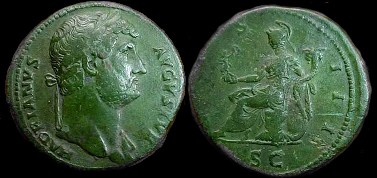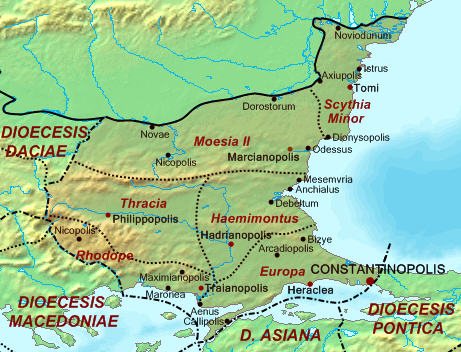|
Gothic War (248–253)
The Gothic War took place between the years 248 and 249, as well as in the year 253. Within this war, a series of Battle, battles occurred and Looting, plundering was carried out by the Goths and their allies in the territory of the Byzantine Empire, specifically in the Balkans. With the cessation of the payment of tribute previously made by the Roman emperor Philip the Arab ( 244–249) to the Tribe, tribes beyond the Danube, the Goths and their allies, led by King Ostrogotha and his subcommanders Argedo and Gundericus, moved towards the Roman border and began a series of attacks, including against the fortified city of Marcianopolis (today Devnya) in Thracia. After these actions, the Goths withdrew with their spoils of war. In 250, the invasions continued, the Carpi people, Carpiani attacked Dacia, while the Gothic King Cniva commanding various groups of Goths and other allied peoples, defeated the Romans in two major battles, in one of these he killed the Roman emperor Decius ( ... [...More Info...] [...Related Items...] OR: [Wikipedia] [Google] [Baidu] |
Balkans
The Balkans ( ), also known as the Balkan Peninsula, is a geographical area in southeastern Europe with various geographical and historical definitions. The region takes its name from the Balkan Mountains that stretch throughout the whole of Bulgaria. The Balkan Peninsula is bordered by the Adriatic Sea in the northwest, the Ionian Sea in the southwest, the Aegean Sea in the south, the Turkish Straits in the east, and the Black Sea in the northeast. The northern border of the peninsula is variously defined. The highest point of the Balkans is Mount Musala, , in the Rila mountain range, Bulgaria. The concept of the Balkan Peninsula was created by the German geographer August Zeune in 1808, who mistakenly considered the Balkan Mountains the dominant mountain system of Southeast Europe spanning from the Adriatic Sea to the Black Sea. The term ''Balkan Peninsula'' was a synonym for Rumelia in the 19th century, the European provinces of the Ottoman Empire. It had a ge ... [...More Info...] [...Related Items...] OR: [Wikipedia] [Google] [Baidu] |
Tribe
The term tribe is used in many different contexts to refer to a category of human social group. The predominant worldwide usage of the term in English language, English is in the discipline of anthropology. This definition is contested, in part due to conflicting theoretical understandings of social and kinship structures, and also reflecting the problematic application of this concept to extremely diverse human societies. The concept is often contrasted by anthropologists with other social and kinship groups, being hierarchically larger than a lineage or clan, but smaller than a chiefdom, nation or state (polity), state. These terms are equally disputed. In some cases tribes have legal recognition and some degree of political autonomy from national or federal government, but this legalistic usage of the term may conflict with anthropological definitions. In the United States, Tribe (Native American), Native American tribes are legally considered to have "domestic dependent ... [...More Info...] [...Related Items...] OR: [Wikipedia] [Google] [Baidu] |
Sestertius Philip 247-lv Lxiii
The ''sestertius'' (plural ''sestertii''), or sesterce (plural sesterces), was an ancient Roman coin. During the Roman Republic it was a small, silver coin issued only on rare occasions. During the Roman Empire it was a large brass coin. The name ''sestertius'' means "two and one half", referring to its nominal value of two and a half ''asses'' (a bronze Roman coin, singular ''as''), a value that was useful for commerce because it was one quarter of a denarius, a coin worth ten ''asses''. The name is derived from ''semis'', "half" and "tertius", "third", in which "third" refers to the third ''as'': the sestertius was worth two full ''asses'' and half of a third. English-language sources routinely use the original Latin form ''sestertius'', plural ''sestertii''; but older literature frequently uses ''sesterce'', plural ''sesterces'', ''terce'' being the English equivalent of ''tertius''. A modern shorthand for values in sestertii is IIS (Unicode 𐆘), in which the Roman numera ... [...More Info...] [...Related Items...] OR: [Wikipedia] [Google] [Baidu] |
Herennius Etruscus
Quintus Herennius Etruscus Messius Decius (died June 251) was briefly Roman emperor in 251, ruling jointly under his father Decius. His father was proclaimed emperor by his troops in September 249 while in Pannonia and Moesia, in opposition to Emperor Philip the Arab. Decius defeated Philip in battle, and was then proclaimed emperor by the Roman Senate. Herennius Etruscus was elevated to in 250, then further raised to in May 251. When the Goths, under Cniva, invaded the Danubian provinces, Herennius Etruscus was sent with a vanguard, followed by the main body of Roman troops, led by Decius. They ambushed Cniva at the Battle of Nicopolis ad Istrum in 250, routing him, before being ambushed and routed themselves at the Battle of Beroe. Herennius Etruscus was killed in the Battle of Abritus the following year, alongside his father. After the deaths of both emperors, Trebonianus Gallus, who had been governor of Moesia, was elected emperor by the remaining Roman forces. Life Qu ... [...More Info...] [...Related Items...] OR: [Wikipedia] [Google] [Baidu] |
Carpi People
The Carpi or Carpiani were a Dacian tribe that resided in the eastern parts of modern Romania in the historical region of Moldavia from no later than c. AD 140 and until at least AD 318. The ethnic affiliation of the Carpi remains disputed, as there is no direct evidence in the surviving ancient literary sources. A strong body of modern scholarly opinion considers that the Carpi were a tribe of the Dacian nation. Other scholars have linked the Carpi to a variety of ethnic groups, including Sarmatians, Thracians, Slavs, Germanic peoples, Balts and Celts. About a century after their earliest mention by Ptolemy, during which time their relations with Rome appear to have been peaceful, the Carpi emerged in c. 238 as among Rome's most persistent enemies. In the period AD 250–270, the Carpi were an important component of a loose coalition of transdanubian barbarian tribes that also included Germanic and Sarmatian elements. These were responsible for a series of large and devastati ... [...More Info...] [...Related Items...] OR: [Wikipedia] [Google] [Baidu] |
Thracia
Thracia or Thrace ( ''Thrakē'') is the ancient name given to the southeastern Balkan region, the land inhabited by the Thracians. Thrace was ruled by the Odrysian kingdom during the Classical and Hellenistic eras, and briefly by the Greek Diadochi ruler Lysimachus, but became a client state of the late Roman Republic and early Roman Empire as the Sapaean kingdom. Roman emperor Claudius annexed the kingdom as a Roman province in 46 AD. Confines From the perspective of classical Greece, Thracia included the territory north of Thessaly, with no definite boundaries, sometimes to the inclusion of Macedonia and Scythia Minor. Later, Thracia proper was understood to include the territory bordered by the Danube on the north, by the Black Sea on the east, by Macedonia in the south and by Illyria to the west, roughly equivalent with the territory of the Thracian kingdom as it stood during the 5th to 1st centuries BC. With the annexation of the Thracian kingdom by the Roman ... [...More Info...] [...Related Items...] OR: [Wikipedia] [Google] [Baidu] |
Devnya
Devnya ( bg, Девня ) is a town in Varna Province, Northeastern Bulgaria, located about 25 km away to the west from the city of Varna and The Black Sea Coast. It is the administrative centre of the homonymous Devnya Municipality. As of December 2009, the town has a population of 8,383 inhabitants.Bulgarian National Statistical Institute - towns in 2009  It lies at the western shore of in the northeastern end of the Devnya Valley an ...
It lies at the western shore of in the northeastern end of the Devnya Valley an ...
[...More Info...] [...Related Items...] OR: [Wikipedia] [Google] [Baidu] |
Marcianopolis
Marcianopolis or Marcianople (Greek: Μαρκιανούπολις), also known as Parthenopolis was an ancient Greek, then Roman capital city and archbishopric in Moesia Inferior. It is located at the site of modern-day Devnya, Bulgaria. The ancient city has been partially excavated and is renowned for its museum collection of ancient mosaic floors from villas in the city. History Roman Emperor Trajan renamed the ancient city of ''Parthenopolis'' after the Second Dacian War, which ended in 106. The city was renamed after Trajan's sister, Ulpia Marciana. An important strategic centre, the city was part of Roman Thrace until 187–193, and then belonged to Moesia inferior. Marcianopolis's prosperity under the Severan Dynasty was ended by a Gothic raid in 248–249 and subsequent barbarian invasions from the north. The Romans repulsed another Gothic attack to this town in 267 (or 268), during the reign of Gallienus. Under Emperor Diocletian Marcianopolis became the ... [...More Info...] [...Related Items...] OR: [Wikipedia] [Google] [Baidu] |
Danube
The Danube ( ; ) is a river that was once a long-standing frontier of the Roman Empire and today connects 10 European countries, running through their territories or being a border. Originating in Germany, the Danube flows southeast for , passing through or bordering Austria, Slovakia, Hungary, Croatia, Serbia, Romania, Bulgaria, Moldova, and Ukraine before draining into the Black Sea. Its drainage basin extends into nine more countries. The largest cities on the river are Vienna, Budapest, Belgrade and Bratislava, all of which are the capitals of their respective countries; the Danube passes through four capital cities, more than any other river in the world. Five more capital cities lie in the Danube's basin: Bucharest, Sofia, Zagreb, Ljubljana and Sarajevo. The fourth-largest city in its basin is Munich, the capital of Bavaria, standing on the Isar River. The Danube is the second-longest river in Europe, after the Volga in Russia. It flows through much of Central and Sou ... [...More Info...] [...Related Items...] OR: [Wikipedia] [Google] [Baidu] |
Tribute
A tribute (; from Latin ''tributum'', "contribution") is wealth, often in kind, that a party gives to another as a sign of submission, allegiance or respect. Various ancient states exacted tribute from the rulers of land which the state conquered or otherwise threatened to conquer. In case of alliances, lesser parties may pay tribute to more powerful parties as a sign of allegiance and often in order to finance projects that would benefit both parties. To be called "tribute" a recognition by the payer of political submission to the payee is normally required; the large sums, essentially protection money, paid by the later Roman and Byzantine Empires to barbarian peoples to prevent them attacking imperial territory, would not usually be termed "tribute" as the Empire accepted no inferior political position. Payments ''by'' a superior political entity to an inferior one, made for various purposes, are described by terms including " subsidy". The ancient Persian Achaemenid Empir ... [...More Info...] [...Related Items...] OR: [Wikipedia] [Google] [Baidu] |







